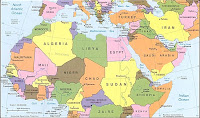At Pakistan Stock Exchange, bullish sentiment
resurfaced in the later part of the week ended 5th May 2017. The
rally was driven by upbeat about earning of listed companies and offtake
announcements by Cements, Urea & POL products). This elevated the benchmark
index by paltry 1.1%WoW to close at 49,851 points, a little shy of 50,000 mark.
Bearish sentiments plunged average daily turnover by 26.4%WoW to nearly 264 million
shares.
Key news flows during the week were: 1) CPI based inflation
for April’17 declining to 4.78%YoY as compared to 4.92%YoY a month ago, 2) Ministry
of Finance agreed to release Rs104 billion to settle
pending power subsidy claims for the current financial year, 3) SECP announced
the criteria for mutual funds’ investment in the listed companies, restricting
investments in illiquid and unprofitable stocks and 4) Supreme Court of
Pakistan formed the joint investigation
team (JIT) comprising of six members from various agencies to investigate
aspects of the Panama papers case against Prime Minister Nawaz Sharif and his
family.
Stock leading the bourse included: NCL, BAFL, EPCL, LUCK,
whereas the laggards were: AGTL, PIOC, SNGP and PTC. FIPI data points to
foreign investors pulling out US$19.28 million during the week accelerating
their exit over last week’s net outflow of US$10.71 million.
The month of May remains a critical for markets as 15th May approaches
closer, for the MSCI revision. Additionally, CPEC summit around middle of this
month in Beijing is expected to boost investors’ sentiment for Construction and
Materials sector. Investors also await the federal and provincial budgetary
incentives expected for the final budget before next election.
OCAC recorded April'17 POL industry sales of 2.22 million
tons rising 16%MoM/11%YoY beating the average seasonal uptick,
based on strong retail fuels sales growth (MOGAS/HSD sales up 12/11%MoM and 14/5%YoY
respectively) and increased generation
on furnace oil (FO). From a cumulative perspective
10MFY17 industry sales now stand at their highest recorded mark of 21.04 million
tons (up 12%YoY) where retail fuel growth led the charge (MOGAS/HSD sales
growth of 17/12%YoY), supported by FO sales growth of 10%YoY. Growth in all
three of these segments, which make up 96% of total industry volumes, bodes
well for market penetrating OMCs focusing on these segments for
growth.
CPPA reported generation numbers for February/March of 2017
where 6.38/7.62TwH were generated. The weighted average cost of generation
during the months stood at Rs5.18/6.22/KwH up 31/12%YoY marking a general rise
in the cost of generation in the public sector. Cumulative 9MFY17 generation
amounts to 76.54TwH rising 5.8%YoY, aided in large part by 5.2%/65.2%YoY
increases in FO/Nuclear generation, at a total net dependable capacity of
11,812MW (50% load factor on nameplate generation capacity of 23,623MW).
Thermal sources for generation supplied 67% of total units produced where
FO/HSD based generation persisted (30.1/1.2%). In a power policy backdrop
riddled by long standing, systemic impediments, a one-off payment before
summer, is a stop-gap measure at best, kicking the can down the road. Investors
agree, as evidenced by the 9.2%CYTD (ex-KEL) decline in the sector's
performance, where an investment case for KAPCO on yield remains compelling,
while a 'chink' in NEPRA's tariff setting authority may give long term space to
push through lucrative tariff for an extension.
Power mix remain steady as generation from renewable,
ex-hydel showed a marked rise with Solar/Wind/Bagasse based projects increasing
units generated by 310/69/63%YoY, but maintain meager shares of 0.6/1.0/0.8% in
the national power mix during 9MFY17. Thermal sources for generation supplied
67% of total units produced as compared to 65% in 9MFY16, where FO/HSD based
generation persisted (30.1/1.2% vs. 30.2/1.7% during 9MFY16). RLNG's share in
the power mix continued to climb (4.9% as of 9MFY17) leading to decline in the share
of units produced from gas, and is expected to continue tracking upwards as
public sector RLNG projects near completion. Moreover, RLNG's cost of generation
for 9MFY17 averages at Rs7.0/KwH, while March'17 cost of generation stood at Rs7.93/KwH,
making RLNG based generation 23.2/49.0% cheaper than FO/HSD sourced units
during the month.
Over the period, combined weighted cost of units
generated by state-owned power plants inched up by 3%YoY, despite a 12%YoY
increase in cost of generated units on FO (Rs8.8/KwH for 9MFY17). Additional
allowances for debt repayment, higher repatriation of funds to provinces has
also pulled up the cost of generation on Hydel by 21%YoY to Rs0.12/KwH, still
the cheapest source of energy in the country. Feb/March'17 weighted average
cost of generation stood at Rs5.18/6.22/KwH up 31/12%YoY marking a general rise
in the cost of generation by public sector GENCOS.
Prominent power sector developments include: 1) Ministry of
finance giving a nod to pay Rs104 billion as part of FY17's provisioned power
sector, consumer subsidy, 2) Prime Minister M expressing dissatisfaction over
persistent power blackouts, burdened by soaring shortfalls (5000-6500MW) and 3)
CCI in its latest meeting approving amendments to NEPRA Act 1997 curtailing
powers of the regulator when setting consumer/power tariffs. In a power policy
backdrop riddled by long standing, systemic impediments, a one-off payment
before summer, is a stop-gap measure at best, kicking the can down the road.
Investors agree, as evidenced by the 9.2%CYTD (ex-KEL) decline in the sector's
performance, where an investment case for KAPCO on yield (FY17/18F D/Y of
11.9/12.2%) remains compelling, while a 'chink' in NEPRA's tariff setting
authority may give long term space to push through lucrative tariffs for an
extension.

